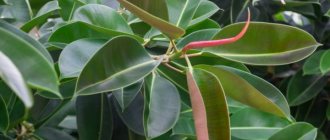Ficus benjamina is an unpretentious indoor plant that is in demand. Florists use it to create an unsurpassed exotic style in the interior. Ficus Benjamin can “live” in a house for many years and grow up to 2 meters; naturally, this is possible with proper care.
As soon as you have a plant, you need to put it in the place where it is supposed to be and wait 1-2 weeks. This is necessary for getting used to. After a few weeks, if necessary, it needs to be transplanted. The plant needs to be watered regularly and monitor the condition of the soil, leaves and bark.
In order for your “room friend” to grow big and beautiful, you need to trim it regularly. Pruning Ficus Benjamin at home is carried out in compliance with certain rules and conditions; you can see more details in the video below. In fact, it is pruning and pinching that is the most difficult stage of care, and the main one for the formation of a tall and beautiful tree.
Beneficial features
In addition to the fact that rubber is extracted from this plant, ficus is also considered the most useful flower, which can significantly improve the health of the air. This happens because air passes through the leaves like through a pipe. During this passage, it is significantly enriched with oxygen.
Another important advantage is the ficus’s ease of care.
When grown at home, it practically does not bloom, is not capricious and can adapt to absolutely any conditions. The only thing is that the plant needs to be kept away from direct sunlight, watered and bathed on time and in the right amount.
Ficus Benjamin: formation of crown and trunk
You can give a decorative appearance not only to the foliage, but also to the trunk. Thanks to its flexibility, beautiful wicker structures are obtained. If there is only one sprout in the pot, then you won’t be able to braid it. You need to wait until it sends out side shoots. Or plant several sprouts at once in a circle or in a line. The height and age of the branches should be approximately equal. Otherwise, the weaker branches will begin to wither due to the fact that the strong ones will oppress them. You can start weaving the trunk only when the trees reach 20-30 cm in height. At this time, make the first turn of the braid and secure it with a cord.
Over time, the weaving will need to be updated, because the thickness of the branches will gradually increase. If the string presses the trunk too hard, milky juice will appear on it. This cannot be allowed. If there are only two stems in the pot, they are intertwined. It turns out to be a beautiful spiral.
Another option: splicing the trunks together. Trees planted in a row or circle can be grown into a hedge. To do this, you need to damage the bark at the same height of two seedlings growing nearby and tie them tightly together in this place.
How to properly pinch at home?
In order for the procedure to be successful, the owner of the ficus needs to know the following:
- It is important to choose the right time for pinching. Otherwise, the plant can easily die.
- Ficus juice is poisonous and can cause burns or allergic reactions. Therefore, all manipulations with the plant must be carried out with gloves.
- It is better not to combine pruning with another procedure, for example, replanting.
Ficus can be easily pinched at home if you follow the established rules.
Timing for the procedure
Experienced gardeners know that the ideal time to pinch out ficus is spring. It is during this period that the plant becomes active, forming new shoots and buds. Therefore, the procedure will not be too stressful for the flower, and all “wounds” will heal quickly.
Important! Pinching in autumn or winter can lead to the death of the ficus.
Pinching Instructions
Before you start forming the crown, you need to decide on the choice of knife. It should be sharp enough to cut thick branches straight away. The knife must be disinfected with alcohol or peroxide. If the plant is young, then unnecessary shoots can simply be cut off.
But if the ficus is already several years old, then you need:
- determine the point that will become the top;
- the cut should be made at a distance of 6–8 cm from the sheet;
- branches should be cut obliquely;
When pinching, it is necessary to rinse all cut areas with water. Since the sap of the plant will slow down the growth of new shoots. To form an ideal crown, pinching and pruning should be done annually.
Important Rules
The procedure for forming a crown largely depends on what the gardener wants to achieve. For example, to obtain the shape of a standard tree you need:
- Choose a young, unformed ficus without lignification.
- Then gradually remove the side shoots until 5 top branches remain.
- When the ficus reaches the required height, the top shoot should be pinched and the side shoots removed.
- For young stems without bark, you need to build a support. It will be needed until the ficus finally grows.
Such a standard can be multi-tiered. To do this, the crown is divided into 4–5 parts. The odd ones will be the crown tiers, and the rest will be the spaces between them. To form the latter, shoots are cut 5–7 cm shorter than in tiers.
In addition to the standard, there are several other ways to design a beautiful crown. This is a bush and an arc. To form the first type, it is important to ensure that the ficus does not grow upward, but produces lateral shoots. This is controlled by pinching the flower annually.
The arch is created very simply - the upper part of the plant is bent and fixed at the required height. The upper buds begin to produce new shoots, making the plant more voluminous. As soon as the side shoots reach the desired length, the fixation is removed. The branches of the ficus will remain in the same position, forming an interesting arc.
Further care
After the stress suffered due to the procedure, the ficus needs additional feeding. It is added immediately or wait 1-2 weeks until the plant adapts. If necessary, you can transplant the ficus into a new pot. This is true for plants that no longer fit in the old container.
How to make a ficus standard
A standard is a tree with a bare trunk and a lush crown. To grow such a specimen, do the following:
- buy or plant a single shoot in the center of the pot;
- as it grows, all lower branches are cut off with a sharp knife;
- a one-year-old plant should have five upper shoots;
- then the plant is grown to the desired height;
- when Ficus Benjamin (formation of the crown, pruning and pinching of which is carried out in the spring) grows to the desired height, they begin to trim it;
- It is better to tie a support to a thin stem, since a young specimen can bend until it gets stronger;
- the lower side branches will have to be pruned constantly to get the desired result.
If you plan to grow a trunk with several levels, then you need to form a central shoot. It will be the basis that will allow you to grow a healthy tree.
Care after pruning
There are a number of rules that must be followed in order for the flower formation process to be successful:
- When cutting, stumps should not be left, as they become hotbeds for the development of fungal and bacterial diseases.
- After pruning, a milky sap begins to ooze from the plant, which must be immediately wiped off and the cut area sprinkled with crushed charcoal or any fungicide.
- You can fertilize the ficus after pruning once a month.
Ficus pruning process
- In addition, after pruning, it is necessary to regularly wipe the leaves from dust in order to reduce the risk of infection of the plant.
- A month after the procedure, when the cut sites have completely healed and the side parts begin to actively grow, the flower can be replanted, and the top layer of the substrate can be changed for mature plants. Experts recommend using the transshipment method in order to minimize the risk of injury to the root system during transplantation.
Further care
Beginner flower growers ask how to make the ficus bush actively.
After pinching the crown, it is very important to provide proper care for the plant.
First of all, it will need to be fed about a month after removing the branches. Replanting won't hurt either - this is another effective way to get side shoots to develop. For those whose home ficus has already acquired an impressive size, this need can be a real problem.
That is why, if desired, simply update the desired composition of the soil without removing the indoor flower from the pot. Knowing what to do to make the ficus bush, you can eventually get a branched plant. Pinch the ficus, taking into account the basic rules and recommendations of specialists, and get the awakening of the buds and the active development of the branches.
Creating unusual shapes
Standard tree
The trunk is created by freeing the trunk from young leaves and twigs to the required height. At the same time, the top is also shortened, and a spherical crown is created around the stem, the correct shape of which must be constantly maintained by removing shoots and pinching leaves in the upper internodes.
Fence
After the mature rubber ficus has been pruned, you can start creating an interesting display in the form of a hedge or fence. Shoots that have been cut off are suitable for this. They are rooted in a shallow but fairly spacious box in one row. As they grow, you can attract the trunks to each other, cutting off the bark at the point of contact and tightly fixing the “wounds” together with film and wire. The more light there is in the room, the faster the branches will grow together at the points of contact and you can start a new row.
Spiral
To obtain a spiral shape, the tree is tied to a strong base (post or stick) and gradually twisting the trunk, securing it with wire or cord. Side branches and leaves should be removed to expose the beautiful, spiral-shaped stem.
Scythe
A very popular type of ficus formation. To do this, 3 young sprouts are planted in a box, and as they develop, the trunks are intertwined in the form of a pigtail, fixing them at the point of contact with polyethylene and wire. At the place of fixation, the bark is removed with a sharp knife, and the milky juice that appears in the “wound” is wiped with a cloth. It is most convenient to start weaving when the plant reaches 15-18 cm in height. The next fixation is carried out as the trunk lengthens, and the lower leaves and shoots are removed.
Pruning is not always necessary to create a neat crown. Ficus provides ample opportunities for flower growers to express their imagination. By following the rules for caring for it, you can create interesting compositions, decorate it in the form of a tree or achieve increased bushiness, thereby decorating the space with an original indoor flower. At the same time, you will not injure the plant, for which cutting is always a powerful stress.
Sculpture - how to create a real masterpiece
In order to create a sculpture, it is important to know not only how to trim the ficus correctly, but also how often this should be done. It must be said right away that creating a sculpture in the form of a bird, flower or the like is a very difficult task that only a good sculptor or designer can handle. In this case, it is necessary to both perform a series of actions aimed at trimming unnecessary shoots, and also have imagination in order to create an exact copy of what was thought up in advance. There will be little ordinary knowledge on the formation of the crown of Ficus Benjamin.
True, you can work hard to create a plant in the form of a cylinder, cone or snake. In this case, it is important to trim the flower so that it acquires the desired shape. In one case, you will need to remove the top shoots, in the other - the side or bottom shoots according to the principle as described above. It should be said that pruning and shaping can take more than one year before the grower gets what he needs.
Very often, to give the trunk an unusual shape, gardeners come up with tricks: they plant several cuttings, which are then woven into a braid; they install a frame for the desired bend and more. If you also use special pruning of the Benjamin ficus, you can end up with an original decorative flower.
Rules for the formation and selection of inventory
For trimming you need to use tools that are convenient and familiar. The main thing is that they are sharp and clean. You can take:
- pruner;
- scalpel;
- garden knife.
To form a ficus you may need:
- garter - ropes, wire, pieces of fabric;
- removal of latex - gauze or cotton swabs, clean rags, napkins;
- treatment of wound surfaces - garden pitch, crushed activated charcoal or charcoal;
- support – pipe covered with coconut fiber;
- stimulator – cytokinin paste;
- to protect hands - gloves.
Pruning and shaping the crown requires following some rules:
- Do not thicken the ficus too much. Leaves should grow freely without interfering with each other.
- Branches should be cut at a right angle, 1-2 cm above the leaf. If the crown is going to be used for propagation, and the internode is too long, the lower part of the cutting is cut off additionally.
- Forming or pruning a weakened, diseased plant cannot be carried out.
- When transplanting, the trunk of the rubber-bearing ficus can be slightly deepened. Sometimes this is enough to increase the stability and decorativeness of the tree.
- With a high probability, after pruning, a side shoot will appear from the nearest upper bud. This way you can control the direction of growth of the ficus.
- It is often advised to remove the milky juice after shaping or trimming and not treat the wound surface with anything, but this is wrong - there is a risk of infection. In addition, activated carbon or garden pitch stops the leakage of latex, and Elastica consists of 15% of it. The top of the trunk will become dry, and the nearest bud and leaf may disappear. This is clearly visible in the photos and videos presented by flower growers who took 1-2 minutes to treat the wound surface.
- Sometimes when pruning and shaping the rubber ficus, it is advised not to leave stumps. But some of the soft wood will still dry out, and if there is not a piece of the stem at least 1-2 cm above the leaf, it will definitely grab the nearest bud with a plate. You'll have to repeat the trimming. It is better to let the process take its course, and then, without affecting living tissue, carefully remove the dried area, leaving 1-2 mm.
- It is recommended to work with gloves so that the rubber sap does not cause irritation when pruning.
- Ficus formation is carried out simultaneously or after the start of feeding. The plant will need additional nutrients to support the growth and development of new branches.
- The transplant is done a few weeks after pruning or shaping. Carrying out simultaneous operations is a lot of stress and greatly depletes the ficus.
How to direct the branches in the right direction?
If you are growing a young Ficus Benjamin, the formation of the crown will require not only the timely removal of apical buds, but also pruning of the side shoots. It happens that pruning greatly exposes the crown of the tree, then it is better to refuse it. It's easier to point the branch in the right direction. Stiff wire is suitable for this purpose. It is wrapped around the protruding process and bent in the desired direction.
If the branches inside the crown cross each other unattractively, you can straighten them by using a wooden spacer.
How to grow ficus benjamina correctly?
Lush branches of the plant begin to form after the top shoot is removed. Ficus benjamina should be pinched when the plant is healthy and full of vigor. It is better to form a crown before reaching the age of three, while it is actively growing. After this time, it is more difficult to give the desired shape, and the restoration process will become a little more complicated. How to pinch ficus benjamina? To do this you need:
- Prepare the plant for the procedure - wash it in the shower and water it.
- Stock up on the necessary tools, water, a clean rag and activated carbon.
- It is recommended to cut thin branches straight, thick branches - obliquely.
- After trimming, the white juice is removed with a wet cloth and the cut is sprinkled with activated carbon.
- When pruning, keep an eye on the shape of the plant so that it has a pleasant, natural appearance.
- Branches that spoil the appearance, grow parallel to the main trunk, intertwine and greatly thicken the ficus must be removed.
- The top and side shoots are shortened to give them the pre-planned shape.
Regular pruning is one of the components of ficus care and is necessary not only for the beauty, but also for the health of the tree.
How to create a standard ficus
Standard forms are no less popular than bushes.
However, in this case, in the first stages, all attention is paid to the trunk. During the growth process, all lateral and lower shoots are removed from the cutting, leaving a couple of upper ones. In the case when a gardener wants the height of his tree not to exceed 50 cm, the “bare” lower part of the trunk cannot be more than 15-20 cm. If we are talking about a meter-long tree, this figure is listed at around 25-35 cm. After the formation of the trunk is completed, it will be possible to begin creating the crown.
To do this, adhere to the following rules:
To begin with, cut off the top shoot by 5-10 cm, and then grow the side shoots. It is necessary to ensure that they do not extend beyond the crown. The branches that form in the lower part of the plant are removed.
From time to time, the side and top parts are pinched according to the same principle as was done with a bush.
If you want the ficus to grow in the form of a trunk, but at the same time have the shape of a ball, you should leave the branches of the same length when pruning.
Timing for the procedure
How to make a ficus branch and how complex is such a set of measures? The result will certainly satisfy you if you not only study the necessary principles of the procedure, but also determine what time of year it is best to carry it out. It is possible to get a branched crown from a ficus, but it is better to start pruning in the spring. With the onset of spring, the plant wakes up and all vital processes are activated. If you start pinching the flower at this favorable time, the pruning procedure will not be too stressful for the plant: all the “wounds” will heal instantly. In addition, it is in the spring that young buds form on the plant stem and side shoots develop.
That is why there is no more suitable time for the formation of a ficus crown than the spring period, or rather the end of winter - the beginning of spring. Remember, it is unforgivable to delay with this procedure. If you start pruning your home ficus in mid-spring, the result may not be of very good quality. The thing is that when sap flow is active, shortening the branches can awaken the flower and stimulate its growth as a whole, but the new side shoots will be too thin.
Important rules regarding pruning
Of course, you can cut all the branches in one fell swoop and consider that the task is completed. This will be partly true, however, in order for the flower to grow and grow in the future, everything must be done gradually.
Any formation of Ficus Benjamin begins no earlier than spring. This is necessary so that before the main growth, all the cuts have time to tighten well.
To carry out the manipulation, you will need to stock up on the following elements in advance:
- charcoal or activated carbon;
- manganese solution or alcohol;
- clean napkin;
- pruning shears
In order to prevent any infection from entering the plant, the pruning shears should be disinfected. This can be done using a manganese solution or alcohol. After which you need to move directly to the cutting itself.
Important! In order to form a ficus, you first need to get rid of excess branches.
As for thick branches, they are cut closer to the bud, at an angle. Young growth is trimmed right above the bud. Upon completion of the procedure, it is necessary to wipe off all the milky juice with a napkin, and rub the sections with activated or charcoal. None of the crown formation of Ficus Benjamin can begin without sanitary pruning, which will be discussed further.
Features of the plant
Ficus rubber (how to form a crown will be described in this article) is a plant that belongs to the genus Ficus of the Mulberry family. The homeland of this representative is considered to be India, namely its northeastern part, as well as southern Indonesia and western Africa. As an ornamental plant, it is grown outside tropical areas. In addition to the decorative function, it can also perform an industrial function, since it is large trees that produce rubber.
When growing in its natural conditions, ficus can reach a size of 40 m in height, while forming so-called support roots. The main feature of the latter is that they descend to the ground and take root in it. If the rubber ficus is grown at home, the maximum growth, as a rule, does not exceed 10 m, if pruning is not carried out.
General pruning rules
Ficus benjamina is pruned at home for the following purposes:
- Rejuvenation. After pruning, the plant begins to grow upward and actively throw out young shoots, which affects the overall time of growth and maturation;
- Design. To give a certain shape, length and width;
- Branch growth modeling. During the pruning procedure, it is possible to simulate the formation and change in the growth of branches, their number, length and width;
- Sanitary purposes. As the plant develops, it will be necessary to get rid of dry or weak (painful) branches and shoots.
Pruning at home is carried out in the spring or, in case of emergency, at any other time, details in this video
In spring, the ficus actively begins to “grow”, so it urgently needs to get rid of dry shoots and weak branches. The formation of lush branches is achieved by pinching off the top shoot growing at the “crown” of the so-called “growth point”. You can pinch out several weeks before transplanting, after which active budding along the trunk will begin, which will provide good “volume”, but will also require additional nutrition. Therefore, after the pinching or circumcision procedure, it would be correct to carry out a transplant.
It is strictly forbidden to prune and replant at the same time; the plant may become thin and die. Ficus needs time to recover, as any procedure will be stressful.
Reasons for pruning and how to do it
As we have already found out, pruning is carried out for three reasons:
- protect against diseases;
- rejuvenate the plant;
- form a crown.
Protective is produced at any time of the year. As soon as we notice that the ficus has dried or damaged leaves, we immediately begin manipulation. You cannot hesitate, because the disease can spread to the healthy part and attract viruses.
It should be shortened even further than to the point where the damage ends. But you shouldn’t get carried away either. The main thing is to leave the stem with at least five leaves and at least 20-30 centimeters of the main stem.
New or axillary shoots always grow from the upper or lateral buds. They are easy to notice above the place from which the leaf grows. If we remove the top buds, the side branches will begin to grow and the plant will begin to grow in breadth.
Also, if we pinch the top, we should not cut off the side branches and leaves. When the young shoot stretches upward, the stalk will remain naked, which will make the plant look unsightly.
On thin stems we cut straight, and on thick stems – at an angle of 45 degrees. Dry the cut site with a cloth until the wound stops oozing. After this, sprinkle the cut with crushed activated carbon.
Below is a visual pruning diagram.
If you pay attention to the diagram, you will notice that the best way is to cut the branches above the second bud, which is directed towards us. Also, we do not leave all the branches that grow inside the bush, they will make the crown thick.
To form a voluminous, compact bush, it is best to prune while it is young. As soon as the branches reach 10-15 centimeters, we remove them. When the young branches reach 8-10 cm, cut off only the tips.
Important
Ficus juice is poisonous. Therefore, we cut with gloves. We hide cats and dogs in another room.
If we need to form a standard bush, that is, an even trunk with a rounded dense crown, we do this:
- We cut off all side shoots.
- We leave five apical buds.
- Shorten the central trunk to the desired height.
- We make a support that is removed as it grows.
- When the shoots from the five remaining buds grow to a height of 5 buds, pinch them again.
- From time to time we pinch the length of the branches to make the crown thicker.
The branched ficus can be shaped into almost any geometric shape: spherical, cone-shaped, cylindrical, pyramidal, and even in the form of steps.
Watch the eight golden rules of pruning in the video:
Sanitary pruning
As for sanitary pruning, it is carried out as needed. It is advisable to carry out the procedure in early spring, but if dry, underdeveloped or diseased branches appear on the plant, then you should not wait for the right moment. Not everyone knows, but such shoots can become a cause that will lead to the occurrence of various fungal infections. Some people are afraid to trim branches that are not needed, although there is nothing wrong with that. Such unnecessary shoots lead to an increase in the density of the crown, which does not allow light to pass inside.
Ficus pruning Melanie
Being one of the varieties of rubber ficus, this specimen also needs pruning. At the beginning of its growth period, this plant is an unbranched trunk with a woody stem. Over time, Melanie begins the process of branching, aerial roots appear, which, reaching the soil, form new trunks. Every owner of this unpretentious species should know how to prune ficus Melanie so that the plant retains its beauty and brightness.
Typically, pruning of this specimen is done at the end of winter. Experts advise how to trim a ficus so that it is fluffy, and emphasize that to do this it is necessary to get rid of the six internodes on top. By cutting off just the top, the grower will not be able to achieve lush development of the branches.
For those who are unsure whether they should prune their ficus this year, there is another method to force the flower to produce side shoots. To do this, the barrel is tilted as low as possible and fixed in this position. After this manipulation, dominance will be transferred to the lateral bud, which is located above the others. The growth of the crown will be stopped, and active growth of lateral shoots will begin.
Root pruning
Sometimes it is recommended to remove not only the branches, but also the roots of the plant, which interfere with development. This type of work requires care and caution, as the health of the flower depends on this. Usually the root is removed when it is infected and the ficus requires replanting:
- After cleaning the soil, the roots are placed in an antiseptic solution.
- Then the injured and interfering processes are removed.
- The sections are sprinkled with activated carbon dust.
- Plant the ficus in another container.
What does ficus bonsai symbolize?
The fact that one tree was grown to its intended form over several generations was a symbol of continuity and tradition. In addition, bonsai shows the three periods of life that every living creature goes through: the beauty and freshness of youth, the beauty of maturity, and the wisdom of old age.
Interesting materials:
How to select several photos at once in iCloud? How to choose arrows in Assassin's Creed Odyssey? How to choose freeze-dried coffee? How to choose fresh peonies? How to choose fresh oyster mushrooms? How to choose a pork neck for barbecue? How to choose your Emoji VK status? How to choose a topic for your book? How to choose thermal underwear for running? How to choose thermal paste for your computer?
Types of pruning
To avoid chaotic growth of shoots, the crown of the ficus must be constantly shaped, otherwise the tree will lose its decorative effect.
Formative
It is carried out during the active growing season, its purpose is to give the crown the desired shape:
- sculptural - removing internal shoots and preserving those that grow outward to ensure active growth of the crown to give it the appearance of an animal, bird or geometric shapes;
- pyramidal - possible only for young specimens using wire and a garter;
- arc - used to grow a visually fluffy ficus by directing the shoots along an arched wire base inserted into a pot with soil and cutting off the top.
Growing ficus in the bonsai style is popular. Step-by-step technology:
- plant the cuttings in a wide flat pot;
- Trim the roots by a third 2–3 times a year;
- upon reaching the required height, pinch the top, provoking the growth of the crown and root system in breadth;
- shorten long shoots;
- give the desired shape to the trunk and branches.
The use of moss, stones and other attributes in the composition increases its decorativeness.
Sanitary
All dry branches, damaged, weakened parts of the plant and yellowed foliage must be removed immediately, regardless of the time of year - they attract pathogenic bacteria and pests, which can gradually spread to the entire ficus.
Rejuvenating
If, as a result of illness or pest damage, the ficus has stopped producing new leaves, and the old ones turn yellow and wither, as well as in case of non-compliance with the rules of care that led to freezing, you will need to trim the tree “under the stump” - remove almost 90% of the shoot, but retaining at least 2 kidneys on the remaining part.
The root system does not die as quickly as the upper part, so this measure helps to save the plant, which will soon resume growth.
Also, regular removal of old, long shoots promotes the appearance of new ones, returns the tree to a decorative appearance and allows you to rejuvenate an adult tree.
Pincing
In order for the ficus to bush better, it is necessary to regularly tweezing. It is pinching the main shoot and side branches that have grown to 10–15 cm that allows you to grow a lush bush from a ficus with a thick, beautiful crown and smaller foliage.
The optimal time for the procedure is from February to July, during the active growing season.
Expert opinion
Mokhov Andrey Petrovich
Graduated from KubSAU, specialty: agronomy
To ensure uniform growth of branches, the tree should be rotated relative to the light source.
Is it possible to trim a ficus?
Pruning a plant is considered a mandatory maintenance activity.
Without this, the plant will not be able to fully develop and be healthy. The procedure must be carried out taking into account the following features:
- Sanitary tree pruning should be carried out regularly. It involves removing dry or diseased branches.
- If the ficus has recently been transplanted into a new pot, it is better to postpone the crown formation process. The plant needs time to adapt. This takes 3-4 weeks.
- Trimming the flower is allowed only during a certain period - from spring to late summer. In winter it remains in a dormant stage. Then metabolic processes slow down, and the ficus may not have enough strength to recover.
Interesting! Thanks to pruning, the plant can be given any shape. So it will become a real interior decoration.











